Innovative Floraflex LED Lights for Sustainable Horticulture
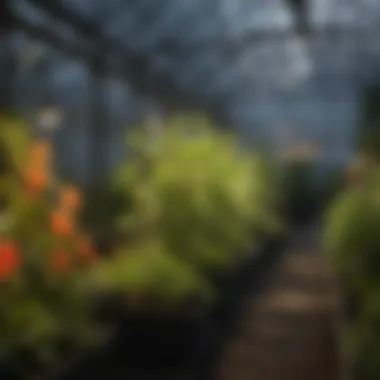
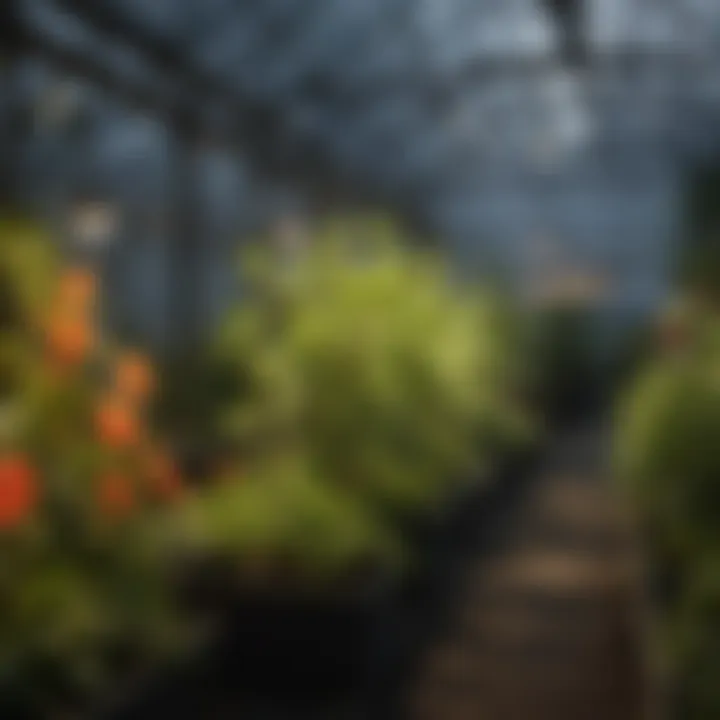
Overview of the Topic
Definition and Importance
Floraflex LED lights are recognized within horticulture for their significant contributions to plant growth. These lights utilize advanced LED technology designed to offer optimal spectrum and intensity tailored for various growth stages. This customization is crucial. Plants require different light wavelengths depending on their development phase, from seedlings to flowering stages. Floraflex has emerged as a leader in this sector, understanding the needs of farmers and enthusiasts alike.
The importance of these lights is not limited to just growth enhancement. They also support sustainable agricultural practices by reducing energy consumption. Sustainable practices are increasingly important amid climate concerns and the push for healthier food systems. Hence, analyzing Floraflex LED lights becomes pertinent in discussing contemporary horticultural innovations.
Current Trends
The current trends in horticultural lighting revolve around efficiency and sustainability. Floraflex LED lights align with these trends by providing a low-energy alternative to traditional lighting systems. The use of full-spectrum LEDs allows farmers to simulate natural sunlight. This technology minimizes the carbon footprint associated with agricultural lighting. Furthermore, increasing interests in indoor and vertical farming create a heightened demand for effective lighting solutions.
Innovative features, like programmable timers and smartphones integration, give users more control over their lighting systems. This trend caters not just to seasoned farmers but also to hobbyists wanting to grow plants at home. As these trends continue to evolve, understanding the impact of Floraflex LED lights on horticulture is crucial.
Key Techniques and Practices
Step-by-Step Guide
Implementing Floraflex LED lights involves several steps to maximize their benefits:
- Assessment of Growth Environment: Understand the space where plants will grow. Factors like space, humidity, and temperature play a significant role.
- Choosing the Right LED Type: Select the appropriate Floraflex model based on the plants’ needs. Some models are better suited for seedlings, while others excel during the flowering stage.
- Installation: Proper installation is critical. Ensure lights are positioned at the right distance from plants to prevent light burn.
- Program Settings: Use programmable features to simulate natural light cycles. Set timers for on/off cycles tailored to plant requirements.
- Monitoring Performance: Continuously monitor plant health and adjust lighting as necessary for optimal growth.
Tools and Equipment Needed
To effectively utilize Floraflex LED lights, additional tools may be necessary:
- Light Meters: Measure light intensity and ensure plants receive optimal levels.
- Timers: Automate lighting schedules to mimic daily light cycles.
- Dimmers: Control light intensity based on plant needs and growth stages.
Challenges and Solutions
Common Obstacles
While Floraflex LED lights offer many advantages, challenges exist. Adjusting to new lighting systems can be overwhelming for some growers. Understanding the best spectrum for different plant types is crucial and often complicated. Additionally, the initial investment in LED technology can be more substantial compared to traditional systems.
Innovative Solutions
Solutions to these challenges include:
- Education and Training: Engaging resources can help farmers understand light spectrum needs specific to their plants.
- Trial and Error Approach: Users can start with a few plants to learn about the lights' effects before fully committing.
- Government Incentives: Some programs encourage the shift towards LED technology through financial incentives.
Understanding and addressing these challenges enhances the integration of Floraflex LED lights in horticulture.
As the agricultural sector continues to evolve, keeping up with innovations in lighting technologies like Floraflex is essential. Embracing such advancements can lead to improved growth results and more sustainable farming practices.
Preface to Horticultural Lighting
Horticultural lighting systems are crucial in the cultivation and production of plants. They provide the necessary light conditions to promote optimal growth, enabling effective plant development year-round, regardless of external weather constraints. Adequate lighting supports photosynthesis, enhances flowering, and cultivates healthy crops.
Many factors influence the choice of horticultural lighting, including energy consumption, initial setup costs, and maintenance. The right choice can increase yields significantly, improve crop quality, and reduce operational costs. Understanding these factors is essential for farmers and horticulturists aiming to maximize their productivity.
The Importance of Adequate Lighting
Proper lighting is a fundamental requirement in horticulture. Plants have specific light needs for photosynthesis, growth, and development. If a plant does not receive adequate light, it may exhibit stunted growth or poor yields. Each type of light emits different spectra that affect plant development in unique ways.
More importantly, consistent light exposure helps prevent pests and diseases. Light patterns play a vital role in the overall health of plants, impacting their resilience against external threats. Thus, selecting the right horticultural lighting system is integral for any grower looking to maintain a vibrant and productive garden.
Types of Horticultural Lighting
Horticultural lighting encompasses various technologies. Each type has distinct characteristics, advantages, and limitations.
Incandescent
Incandescent lighting has been a staple for many years. It provides a warm light, which can be beneficial for certain plants that thrive in warmer conditions. The key characteristic of incandescent lights is their affordability and ease of use. However, they are not energy efficient, converting most energy into heat rather than light. This can lead to excessive energy costs and potential heat damage to plants.
In this article, the role of incandescent lights is primarily seen as a historical step in lighting technology. Their use is declining as more efficient options become available.

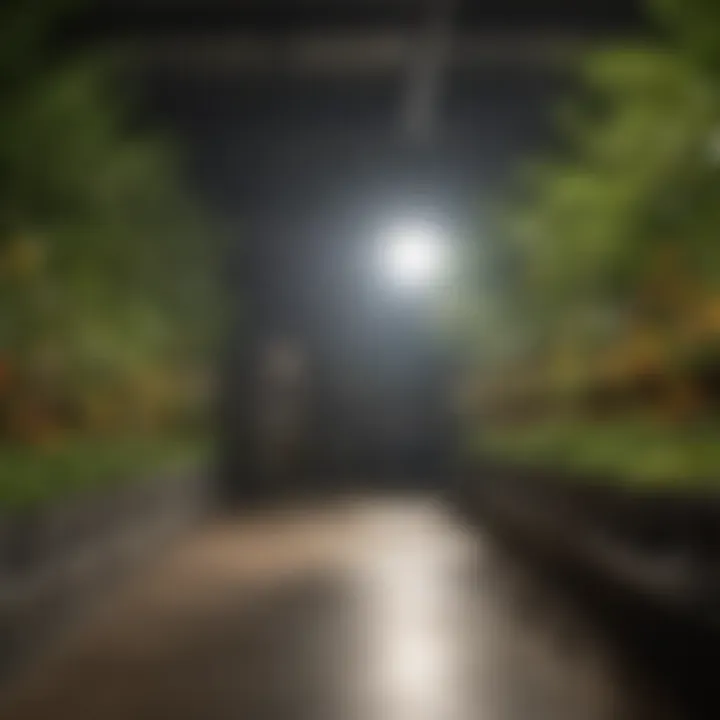
Fluorescent
Fluorescent lights are another common choice among growers. They are more energy-efficient than incandescent lights and can provide a spectrum closer to natural daylight. Their key advantage lies in their ability to emit less heat, reducing the risk of plant burnout. Fluorescent fixtures are widely used for seed starting and growing leafy greens.
However, they have their downsides. Fluorescent lights might not penetrate deep foliage as effectively as other types, potentially limiting their use for larger plants.
High-Intensity Discharge (HID)
HID lights are powerful sources of illumination that are popular in commercial horticulture. They produce a significant amount of light while consuming less energy than incandescent systems. The main advantage of HID lights is their ability to penetrate deep into the plant canopy, promoting robust growth in larger plants.
Nonetheless, HID lights generate considerable heat and require additional cooling measures in growing spaces. This can increase operational costs and complicate installation.
LED Technology
LED technology has transformed the approach to horticultural lighting. Their ability to emit specific wavelengths tailored to plant needs makes them a popular choice. LED lights are energy-efficient, long-lasting, and produce less heat. The flexibility to customize the light spectrum allows for optimized growth stages, from seedling to flowering.
In this article, LED technology represents the forefront of agricultural innovation, showcasing how it can enhance efficiency and sustainability in horticulture. The advantages of using LEDs are numerous, marking a shift toward smarter farming practices.
Overview of Floraflex LED Lights
The Overview of Floraflex LED Lights is essential in understanding the current advancements in horticultural lighting. These lights represent a significant evolution in how we grow plants indoors, enhancing both efficacy and sustainability. Floraflex has invested deeply in research and development, creating products that meet contemporary agricultural demands.
Innovations in LED Technology
Floraflex LED lights incorporate cutting-edge technologies that set them apart in the horticultural lighting sector. Their focus on full-spectrum lighting stands out. The full spectrum supports various growth stages, from seedling to flowering, by mimicking natural sunlight. This characteristic is crucial for optimizing plant photosynthesis.
Additionally, their use of coherent light wavelengths allows plants to absorb light more efficiently, maximizing energy use. The lights are designed to operate with minimal heat output. This means growers can maintain optimal growing conditions without excessive cooling systems.
The integration of smart technology is also a trend among Floraflex products. These lights can sometimes sync with environmental sensors to deliver precise light intensity and duration based on plant needs. This adaptability not only enhances growth but it also reduces energy wastage.
Design and Build Quality
The design and build quality of Floraflex LED lights is another critical factor. These lights are often constructed with robust materials that ensure durability in demanding growing environments. The heat dissipation technology in their designs prevents overheating, extending the lifespan of the lights significantly.
Moreover, many Floraflex models come with adjustable mounting options. This flexibility aids growers in selecting the best heights and angles for their specific setups, further optimizing light exposure for plant health.
A well-designed lighting system not only increases yield but also enhances plant quality, providing a significant edge in agricultural practices.
In summary, the overview of Floraflex LED lights provides a deep understanding of their innovations and design integrity. This knowledge equips growers with the information they need to enhance their horticultural practices effectively.
Advantages of Using Floraflex LED Lights
The use of Floraflex LED lights brings several advantages to horticultural practices. These benefits are crucial for enhancing plant growth while optimizing energy usage and sustainability. Understanding these advantages helps farmers and enthusiasts make informed decisions that positively impact their gardening and farming efforts.
Energy Efficiency
Floraflex LED lights are known for their impressive energy efficiency. Compared to traditional lighting options, such as incandescent or fluorescent lights, these LEDs consume significantly less electricity for the same amount of light output. This is advantageous for growers looking to reduce operational costs.
In addition to lower energy costs, LEDs generate less heat, which means that the risk of damaging plants due to excessive heat is reduced. This feature allows for closer placement of lights to the plants, enhancing light exposure without harming them.
"Switching to Floraflex LED lights can lead to up to 50% savings in energy costs, depending on usage patterns and system design."
Longevity and Durability
The longevity and durability of Floraflex LED lights are major selling points. Unlike traditional bulbs, which may need frequent replacements, these LEDs can last for tens of thousands of hours. This extended lifespan reduces the need for replacement and maintenance, proving economically beneficial in the long run.
Their build quality is another factor. Floraflex LEDs are designed to withstand the rigors of horticultural environments, including humidity and moisture. This resilience means they are less likely to fail due to environmental stressors. For growers, fewer replacements and maintenance activities can translate into more time focusing on plant care rather than lighting upkeep.
Spectral Flexibility
One of the standout qualities of Floraflex LED lights is their spectral flexibility. This means that users can tailor the light spectrum to match the specific needs of their plants at various growth stages.
For instance, during the vegetative stage, plants thrive under blue light, which promotes strong stem growth and leaf development. During flowering, red light can enhance bud formation and overall yield. Having the capability to adjust these spectrums according to the plants' requirements can lead to optimized growth results.
Effects of Floraflex LED Lights on Plant Growth
Floraflex LED lights have revolutionized the way we approach plant cultivation. Their impact on plant growth is significant and multifaceted. Understanding this impact is essential for farmers and horticulture enthusiasts looking to maximize their efforts. Adequate light is vital for photosynthesis, the process through which plants convert light energy into chemical energy. Floraflex LED lights are designed to optimize this process, leading to healthier plants and increased productivity.
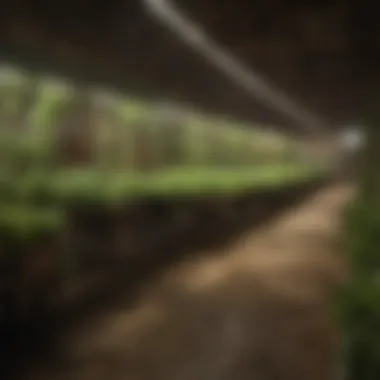
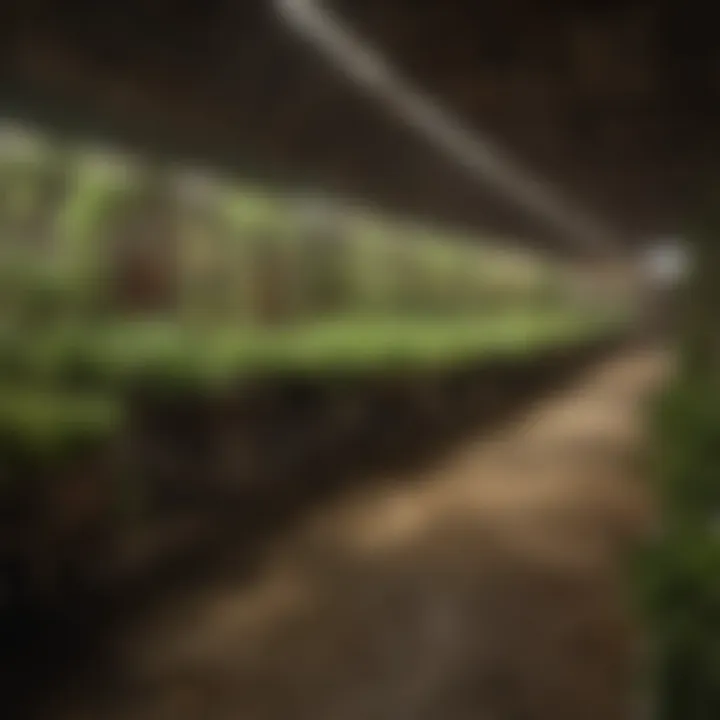
Photosynthesis Enhancement
The enhancement of photosynthesis is one of the most critical aspects of Floraflex LED lights. These lights emit specific wavelengths that are most effective for photosynthesis, particularly in the blue and red spectrum. Research shows that plants absorb light in these wavelengths much faster than in others. By using Floraflex LED lights, growers can stimulate more efficient photosynthesis, resulting in improved plant vigor.
Some key points to consider include:
- Optimal Wavelengths: Floraflex LED lights are engineered to focus on wavelengths that plants absorb best, facilitating better energy conversion.
- Consistent Growth: With enhanced photosynthesis, plants experience consistent growth rates, reducing the time to harvest.
- Healthy Foliage: Improved light conditions lead to robust foliage, increasing the plant’s overall health and resilience to diseases.
"The transition to LED technology marks a turning point in horticultural lighting efficiency."
Impact on Yield Quality
The impact of Floraflex LED lights extends beyond growth rate; it also significantly influences the quality of the yield. Quality is not just about size but also encompasses taste, nutrient content, and overall health of the plant. Floraflex lights contribute to these attributes in various ways.
Factors influencing yield quality include:
- Stress Reduction: Proper lighting reduces plant stress, allowing for a more uniform development and better quality produce.
- Nutritional Value: Some studies indicate that plants grown under better lighting conditions exhibit higher nutritional content. The careful calibration of light from Floraflex enhances these attributes.
- Flavor Improvement: For food crops, the composition of certain compounds are influenced by light. Floraflex LED lights have been shown to enhance the flavor profiles of vegetables and fruits.
Utilizing Floraflex LED lights not only provides a better yield but also ensures that the produce is of superior quality, fulfilling both aesthetic and taste expectations.
Installation Guidelines for Floraflex LED Lights
Proper installation of Floraflex LED lights is critical to maximizing their effectiveness in horticultural applications. Installation affects not only energy efficiency but also plant health and growth rates. Thus, understanding the specific requirements and strategies is key for both novice and experienced growers.
Optimal Placement Strategies
To achieve optimal results, the placement of Floraflex LED lights must be carefully planned. The height at which lights are installed can significantly influence photosynthesis and overall plant health.
- Distance from Plants: It is essential to maintain an appropriate distance between the light and the plant canopy. Generally, a height of 12 to 24 inches is recommended depending on the light output and plant species. Closer lights can lead to photobleaching and stress, whereas lights too far away may not deliver enough energy.
- Light Coverage: Ensure that the light covers the entire growing area uniformly. Uneven light distribution can result in variable growth rates across the plants. Using reflective materials such as Mylar or flat white paint on walls can enhance light distribution.
- Adjustability: The use of adjustable mounts allows for flexibility in managing growth phases. Seedlings may require closer light placement, while mature plants might benefit from elevated positioning.
By considering these factors, growers can create an environment that promotes healthy growth and improves yield quality.
Electrical Requirements
Understanding the electrical requirements of Floraflex LED lights is essential for safe and effective operation.
- Voltage and Amperage Ratings: Ensure the lights are compatible with the electrical system in use. Floraflex LED lights typically operate on standard voltage configurations but must be checked against specifications before installation.
- Dedicated Circuitry: It is advisable to use dedicated circuits for high-wattage setups. This prevents overload and maintains circuit integrity, promoting a safer environment.
- Power Source Accessibility: Position the lights near a reliable power source to avoid excessive extension cords, which can be both unsightly and unsafe.
- Timer Integration: Consider integrating a timer for automated light cycles. This allows for consistent light exposure, which is crucial for plant development.
"Proper installation is often overlooked, yet it can make or break horticultural efforts."
By adopting these guidelines, growers align with best practices, setting the stage for successful plant cultivation.
Comparative Analysis with Other Lighting Solutions
When discussing horticultural lighting options, it proves vital to undertake a comparative analysis. This analysis helps illuminate the specific advantages and shortcomings of each solution, particularly Floraflex LED lights versus other technologies. Understanding these differentiating factors enables horticulturists to make informed decisions tailored to their unique cultivation needs. An examination of LED technology, alongside High-Intensity Discharge (HID) lights, reveals essential insights about energy consumption, light quality, and environmental impact.
LED vs. HID Lights
LED lights have emerged as a revolutionary force in horticultural lighting. Their advanced technology offers significant advantages over traditional HID lights, which were previously the gold standard. One primary difference lies in energy efficiency. LED lights consume considerably less power—typically around 50% less than HID lights—while providing comparable or superior light intensity.
Additionally, LEDs produce less heat during operation. This reduced thermal output means less energy wasted and mitigates the risk of overheating sensitive plants. Growers can achieve optimal growing conditions without supplemental cooling systems that increase operational costs.
HID lights, on the other hand, often generate excessive heat, requiring constant temperature monitoring. This increases labor and equipment costs. Furthermore, while HID lights can emit a broad spectrum of light, they do not generally provide the targeted wavelengths beneficial for particular plant growth phases.
In terms of lifespan, LED lights also outperform HID alternatives significantly. Typically, Floraflex LED lights can last up to 50,000 hours, markedly extending the time between replacements. Conversely, HID lights usually last between 10,000 to 24,000 hours, necessitating more frequent changes and additional disposal considerations.
Cost-Benefit Comparison
In relation to initial cost, Floraflex LED lights may have a higher upfront price tag than traditional HID systems. However, when evaluating long-term costs and efficiencies, LEDs often prove more economical over time. Factors to consider in the cost-benefit analysis include:
- Energy Savings: Lower electricity bills due to reduced consumption.
- Maintenance Costs: Less frequent replacement requires fewer labor hours and management attention.
- Environmental Impact: With less energy use comes a smaller carbon footprint, which is increasingly an important factor in sustainable farming practices.
"Investing in LED technology represents not just an upgrade in lighting, but a shift towards more sustainable agricultural practices."
When you integrate these considerations, the advantages of Floraflex LED lights become apparent. While upfront costs might be a barrier, the savings in energy and maintenance justify the investment. This makes LEDs a practical choice for many in the horticultural community.

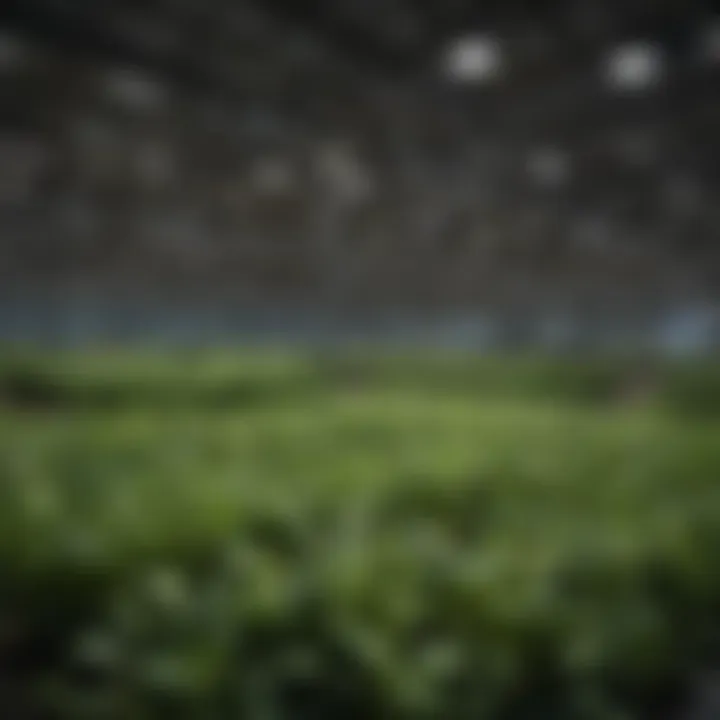
In summary, the comparative analysis between Floraflex LED lights and other lighting solutions presents compelling evidence for adopting LED technology in horticulture. With their energy efficiency, longevity, and targeted light spectrum, LEDs clearly position themselves as forward-thinking alternatives that support both horticultural productivity and environmental stewardship.
Sustainability Perspective
Sustainability is an essential consideration in horticultural practices today. As environmental concerns grow, the agricultural sector increasingly seeks ways to minimize its impact. Floraflex LED lights present a significant opportunity for sustainable horticulture. By incorporating energy-efficient technologies, these lights not only enhance plant growth but also address broader environmental issues.
Reducing Carbon Footprint
The use of Floraflex LED lights contributes to reducing the carbon footprint of agricultural operations. Traditional lighting systems often consume large amounts of electricity, leading to higher carbon emissions from power plants. In contrast, Floraflex LED lights consume significantly less energy. The lower energy consumption has the direct effect of decreasing the greenhouse gas emissions associated with agriculture.
Additionally, LED lights are designed to last longer than their incandescent and HID counterparts. This longevity means fewer replacements and a reduction in waste. Each time a light is replaced, it requires manufacturing, shipping, and disposal, all of which add to the carbon footprint. By reducing the frequency of replacements, air pollution caused by production and transportation is minimized. Thus, switching to Floraflex LED lights is a proactive step towards more sustainable farming practices.
Water Usage Efficiency
Water is another critical resource in agriculture, and optimizing its usage is paramount for sustainability. Floraflex LED lights support water usage efficiency in several ways. First, these lights can be tuned to emit specific wavelengths that promote faster plant growth. When plants grow more quickly, they reach maturity sooner, which can lead to a reduced need for extended irrigation.
Furthermore, with efficient lighting, plants can achieve optimal photosynthesis at lower light levels. This means less water is needed to support plant growth. Farmers using Floraflex LED technology may notice that their plants require less water compared to using older lighting technologies.
The ability to optimize both light and water can lead to significant resource savings in horticulture. This efficiency not only aids in protecting water supplies but also enhances the overall resilience of agricultural systems facing climate stress.
"Utilizing energy-efficient LED lights is not just a choice; it is a responsibility toward sustainable agricultural practices."
Future Trends in Horticultural Lighting Technology
The exploration of future trends in horticultural lighting technology holds significant relevance for the agricultural sector. As the demands for efficient and sustainable farming grow, the integration of innovative lighting solutions becomes crucial. Constant advancements in technology present opportunities for optimized plant growth and resource management. These trends not only elevate production capacities but also contribute to improved sustainability practices among farmers.
Smart Lighting Systems
Smart lighting systems are one of the most promising developments in horticultural lighting. These systems utilize advanced controls to adjust light intensity and duration based on the specific needs of plants. With the help of automation, farmers can synchronize lighting schedules with the plants' growth cycles. This optimization leads to enhanced photosynthesis, ultimately boosting yield quality. Furthermore, smart systems can integrate with IoT devices to monitor environmental conditions. These insights help ensure that lighting conditions are always optimal.
Benefits of smart lighting systems include:
- Energy savings: They decrease energy use by providing the right amount of light when it is needed.
- Precision control: Farmers can fine-tune lighting parameters to match plant growth stages.
- Remote management: Many smart systems allow control through mobile devices, giving flexibility to growers.
- Data collection: They generate valuable insights through real-time monitoring, helping in decision-making.
Advancements in Sensor Technology
Advancements in sensor technology play a crucial role in optimizing horticultural lighting solutions. Sensors can monitor light levels, temperature, humidity, and even the growth of plants. For instance, photodetectors measure the intensity of light reaching plants and can trigger adjustments in LED brightness. Other sensors can analyze soil moisture and send signals to the lighting system when conditions demand a change.
The integration of sensors brings numerous advantages:
- Real-time responses: They provide immediate feedback that allows rapid adjustments.
- Detailed analytics: Data from sensors can help identify patterns in plant growth and environmental interactions over time.
- Resource management: By understanding plant needs more accurately, farmers can minimize waste and improve efficiency.
This emergence of smart lighting systems and sensor technology represents a clear trend towards greater precision in horticulture. As innovations continue, the agricultural sector can expect more sophisticated and adaptive lighting solutions that will enhance the cultivation landscape.
Culmination and Takeaways
The conclusion serves as the final synthesis of all observations and insights gleaned throughout this article. Specifically, it reinforces the role of Floraflex LED lights as a critical component in modern horticulture. By understanding the various aspects discussed, readers can appreciate the significance of employing appropriate lighting in agricultural practices. The goal is to ensure sustainable growth and optimal yield.
One crucial takeaway is the energy efficiency of Floraflex LED lights compared to traditional lighting options. Not only do they consume less electricity, but they also provide longer service life, which results in reduced operational costs over time. This is particularly beneficial for large-scale agricultural operations where energy savings can translate to considerable financial benefits.
Furthermore, the spectral flexibility discussed in the earlier sections indicates the versatility in optimizing light for different plants at various growth stages. This flexibility supports enhanced photosynthesis and improvements in crop quality and yield.
Research into future trends in horticultural lighting underscores the potential for integrating smart technologies. The advancements in sensor technology discussed earlier suggest that upcoming innovations could further enhance the efficiency of lighting applications.
Overall, the convergence of energy efficiency, longevity, and advancements in technology positions Floraflex LED lights as a top choice for those serious about horticulture.
"Investing in modern lighting technology is essential for achieving sustainable agricultural practices."
Key Insights on Floraflex LED Lights
Floraflex LED lights are crafted with a focus on innovation and meeting the specific needs of growers. Some key insights include:
- High-PAR Efficacy: The lights deliver high Photosynthetically Active Radiation (PAR), which is crucial for plant growth and development.
- User-Friendly Design: The build quality of these lights ensures ease of installation and maintenance.
- Sustainability: Floraflex takes pride in producing energy-efficient lighting that not only benefits growers but also has a reduced environmental impact.
These insights emphasize how Floraflex is not merely about providing light but enhancing the entire horticultural experience through technology.
Recommendations for Implementation
When considering the adoption of Floraflex LED lights for horticulture, the following recommendations should be noted:
- Assess Crop Requirements: Understand the specific lighting needs based on your crops' growth stages and select the appropriate light spectrum.
- Proper Installation: Follow the optimal placement strategies to avoid hotspotting and ensure even light distribution, which is essential for uniform growth.
- Monitor Performance: Utilize compatible sensor technologies to monitor plant response to lighting and adjust as necessary.
- Evaluate Energy Savings: Calculate the operational cost savings to justify the initial investment in high-quality lighting systems.
In summary, adopting Floraflex LED lights not only enhances plant growth but also fosters a sustainable agricultural environment, making them a viable option for both small-scale and large-scale operations.



